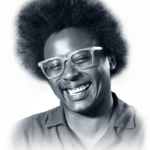-
DESCRIPTIONWhen technologists design exciting new innovations, those designs rarely include blind people. Advocates urge us to employ a variety of strategies, Access to technology and information is a civil right. Yet when technologists design exciting new innovations, those designs rarely include blind people. Advocates urge us to employ a variety of strategies, from education to litigation, to ensure accessibility is baked into all future tech and information systems. Harvard Law’s first Deafblind graduate Haben Girma, disability rights attorney Lainey Feingold, and Chief Innovations officer with the DAISY Consortium, George Kerscher will discuss strategies for creating a future fully accessible to persons with disabilities, including those who are Black, Indigenous, People of Color, and persons with print disabilities.
Speakers
-
Haben Girma, Disability Rights Lawyer

-
Lainey Feingold, Disability Rights Lawyer

-
George Kerscher, Chief Innovations Officer, The DAISY Consortium

-
Moderator: Megan Rose Dickey, Senior Reporter, TechCrunch

-
-
SESSION TRANSCRIPT
[MUSIC PLAYING]
MEGAN ROSE DICKEY: Thanks for that intro, Will. So I know that this is a panel about the accessible future, but I would actually like to start off with talking about the present, given the recent reliance on videoconferencing services and virtual event platforms like Zoom, and Google Meet, and Hopin, and others. So I wanted to first kick this off to Haben. Would you tell the audience about the technologies you use to communicate and what it’s like for you using Zoom and other video services.
HABEN GIRMA: Hi, everyone. This is Haben speaking. A quick visual description– I’m sitting in my living room on a black sofa wearing a red sweater. My black hair is to the side. I’m speaking with my own voice. I’m deaf-blind, and people often ask, how do you speak if you can’t hear?
There are many different ways to communicate in the deafblind and deaf community. Some use voice. Some use sign language. Some use technology. For expressive communication, I’m using my voice. To understand what people on this panel are saying, I’m using one piece of technology called a BrailleNote Apex. It’s a Braille computer.
I’m holding it up. There’s Braille dots along the bottom. I run my fingers over the dots and feel the letters. As people speak on the panel, I have an assistant typing on a keyboard what’s being said. I’m reading the words in Braille and then responding back by voice. Thanks, Megan.
MEGAN ROSE DICKEY: Yeah, thanks for that response. And I’m curious. So it sounds like it’s relatively easy for you to transfer your pre-existing process for communication and then using it on platforms like Zoom and others. Would you say that’s correct?
HABEN GIRMA: [LAUGHING]
Haben speaking. If you’re adaptive, things can generally be easy. And if tools are designed to be accessible, then it can be easy. So there are deafblind people who use Zoom independently. I’m using this with a sighted assistant for communication purposes. I need someone to actually type on the keyboard. And then, I can respond by voice and read what’s going on in Braille.
That assistant, technically, could be a blind person. And I’ve had blind typists in the past. I’ve also had deaf typists in the past, where they were watching a sign language interpreter and interpreting and typing what they were seeing, or they were watching the visual [? cut ?] and typing what they were seeing. Interdependence– disabled people help other disabled people all the time.
MEGAN ROSE DICKEY: Got it. Thanks for that, Haben. And George, I’ll throw this to you. I guess, what are your preferences when it comes to these online services, whether it’s Zoom or Google Meet/Hangouts– whatever they’re calling it these days– and the other virtual events platforms?
GEORGE KERSCHER: So I’m blind, and I use speech. So I hear– the computer talks to me. But Zoom, they’ve done a really great job on accessibility of the interface. And that’s not true for many of the other systems that are out there.
And I’m not going to name any of them, but I called one of these companies up and asked for tech support because I was having so many problems using their platform. And they said, we have no plans on addressing accessibility issues. And I don’t think that company’s in business anymore.
[CHUCKLES]
MEGAN ROSE DICKEY: That’s good.
GEORGE KERSCHER: Yeah, Zoom’s done a great job. And I think that companies that have legal requirements to use accessible technology would gravitate to Zoom and steer clear of some other things. I’m not the legal person on this panel, but, boy, I promoted the heck out of Zoom in the early days because of their fabulous job they did with accessibility.
MEGAN ROSE DICKEY: Yeah, and I mean, Lainey, you’re a lawyer, so you’re on the legal side of these issues. And I guess, even regarding the company that George spoke about, isn’t it illegal for them to not focus on accessibility? Or I guess, what do you think was happening there?
LAINEY FEINGOLD: Well, there is a lot of legal activity going on in the United States, especially since COVID has shown a light, really, on the need for technology to work everywhere. And that means it needs to be accessible for disabled people. And our Americans with Disabilities Act and anti-discrimination laws are about inclusion. And what George described is about exclusion. So there has been a lot of activity. And I expect, since we’re talking about the future, to see more of that in the coming years.
MEGAN ROSE DICKEY: So some more litigation, you’re thinking?
LAINEY FEINGOLD: Yeah. I mean, people who know me know that I believe in collaboration, and I think it’s really important. I also believe in civil rights lawsuits. Unfortunately, in the United States today, we have a lot of lawsuits that really aren’t civil rights lawsuit, that are kind of in the guise of civil rights lawsuit. But, in fact, I consider them opportunistic cases because they’re not focused on disabled people and inclusion.
So yes, litigation, but to the extent we’re going to talk in this panel about the future, collaboration has to be key. Yes, civil rights– true civil rights– litigation will be important. But there is so many parties and so much interest. And like [? Yuta ?] has said in the previous panel, it’s all about a culture change to really make sure technology is accessible for everyone. And you can’t get a culture change, I don’t believe, by hammering people. You get a culture change by having conversation and relying on civil rights laws but not as the hammer.
MEGAN ROSE DICKEY: So relying on the civil rights laws to guide the conversation but not as the sole tool, essentially.
LAINEY FEINGOLD: Yeah. I mean, like I said, civil rights lawsuits have been very, very important in enforcing the ADA, and I believe in them thoroughly. I also think that the tool of collaboration is going to be particularly important as we move forward with AI and other technologies. There’s an entire ecosystem. The law tends to be narrow. The law tends to be slow.
So the ADA has been a crucially important law and just had our 30th anniversary. Hope to have 30 more years. It’s going to play a crucial role going forward. But it’s really important how we use the law. And remember that it’s not about technical compliance, it’s about inclusion and civil rights.
MEGAN ROSE DICKEY: And so what type of collaborations are ideal? Or, I guess, looking ahead, what do you envision?
LAINEY FEINGOLD: Well, one kind of exciting thing is I’ve done some work in Basque country, Spain, and they have an accessibility plan. And in the plan, it specifically says– I did the Google Translate, thank you, Google– it is necessary to anticipate possible disagreements between different interest groups, and collaborative solution formulas or new approaches must be developed. New approaches must be developed, like structured negotiation, which is a type of collaboration that I practice.
So like I said, civil rights laws are important. But I think involving disabled people in every step of the way is key. And some of the problems we see now in technology– quick-fix solutions, so-called solutions that Haben and George can talk more about– is that disabled people haven’t been involved and that the collaboration between people with disabilities throughout the ecosystem of technology development is missing in some of the fancy new, sparkly tools. And that’s a danger.
MEGAN ROSE DICKEY: Yeah, Haben, you actually wrote an op-ed on TechCrunch maybe a few months ago. Sorry– it’s hard to keep track of time these days. But you wrote about those sidewalk delivery bots and your experience with them and how the delivery bot wouldn’t move when it encountered you. And I guess I’m curious, what kind of response did you get from that article? Have you heard from that company at all? Or where does that stand for you right now?
HABEN GIRMA: Haben speaking. So background on the story– when the pandemic started, everyone was looking for no-contact solutions, including for groceries and deliveries. We wanted to minimize interactions with other people, especially people outside our pods and bubbles.
So this company that had been working for a few years called Starship had delivery robots. And they began popping up in more cities advertised as a solution during the pandemic to minimize contact with other people. Because these robots would deliver groceries and deliver restaurant food services.
I wanted to try using this because blind people also need no-contact solutions during the pandemic. I tried the app. That wouldn’t work. Blind people can use apps that are designed to be accessible. This app would not work with VoiceOver on the iPhone. And that’s not fair, nor is it right. There’s a legal requirement under the ADA for apps to people be fully accessible to blind people.
The other element is that these robots blocked access on the sidewalk. As a blind person, I technically can walk around them. This is more of an issue for people with physical disabilities who may not be able to easily move off the sidewalk if there isn’t a curb cut right there for them to move off the sidewalk. And it’s dangerous to spend more time on the street rather than on the sidewalk.
The ideal situation would be for the company designing these robots to work with disabled people. Blind people, wheelchair users, people with all kinds of different disabilities, use our sidewalks and would benefit from delivery apps. But unfortunately, we have these issues continuing to exist, where these robots are expanding, these delivery services are expanding, and disabled people are being denied from these services and also being denied full access to sidewalks.
MEGAN ROSE DICKEY: Yeah, absolutely. That kind of reminds me just of all of the– like, Lyft and Uber have faced just so many lawsuits regarding their lack of accessibility to people who rely on wheelchairs. There’s such a small number of vehicles available. And it kind of falls into that move fast, break things kind of motto that Silicon Valley has, unfortunately.
And yeah, this also kind of falls into– on one hand, there’s the issue with– back that Starship– there’s the issue with the app itself not being accessible. And there’s also the issue with it’s a robot, and it’s not understanding that it needs to get out of the way. And I think when we talk a lot about AI fairness, a lot of those conversations can center around race. And I guess back to you, Haben, but do you feel like that conversation has really been applied to accessibility and disability?
HABEN GIRMA: Haben speaking. The people I know in the disability community and the people I know in the AI community are having these conversations. But not enough people building the robots and using the AI are having these conversations. Don’t blame the robots. It’s the people who build the robots–
[LAUGHTER]
–and the algorithms who are inserting their biases that are causing ableism and racism to continue in our society. If designers built robots in collaboration with disabled people who use our sidewalks and blind people who would use these delivery apps, then the robots and the delivery apps would be fully accessible. So we need the people designing the services to have these conversations and work with us.
MEGAN ROSE DICKEY: And so, George, on our prep call, you kind of talked about the publishing industry and how it’s actually really embraced accessibility, especially with e-books. So I guess I’m wondering, what do you think the tech industry can learn from the publishing industry?
GEORGE KERSCHER: So, of course, the publishing industry started out as being completely inaccessible with print, and blind people and people with all kinds of other disabilities– there’s a term, print-disabled– people who cannot read print, dyslexic people, people with orthopedic difficulties that can’t turn pages. And the publishing industry was always supportive, but there was nothing to do.
So when the digital book evolution started, it was very interesting to see the disability community join in that standards development and technology development. And the publishing industry joined in right along. And the publishing industry has embraced accessibility in the EPUB 3 standard.
We’re seeing now, in higher education, that the top publishers, all of them, have embraced EPUB 3 and are building accessibility right into their systems. But it’s also a collaboration with the tech sector. Because you’ve got publishers producing the content. And then you’ve got the tech companies that produce the authoring tools that produces the content, and then the reading systems that deliver the user interface to that content.
And so the tech companies really have to embrace the technologies and work with the assistive technology vendors, the screen readers, the screen enlargement, the voice recognition– all of the things that people with disabilities use to access computers and smartphones. Because if that aspect of things is not accessible, then you can can’t get at the underlying accessible content. So it’s content married with reading system accessibility. And that’s super, super important.
MEGAN ROSE DICKEY: Yeah, and, George, I know that you’ve mentioned that you’ve been really happy with how Zoom has addressed accessibility. And I’m curious, outside of video conferencing, are there other examples of tech companies that you think are actually doing a good job and setting an example for other tech companies?
GEORGE KERSCHER: I think there’s quite a few really, really good examples. I know Microsoft is doing a lot in terms of accessibility. They’ve done all kinds of training internally for their organization. They’ve helped the DAISY Consortium financially. We put out the WordtoEPUB tool, which is free and open source. And it’s just made it so drop-dead easy to make fully accessible EPUB publications. And so Microsoft’s done a good job.
Of course, Apple, way back when, they were faced with a legal challenge regarding iTunes U. And most of the time, companies would fight back at this legal challenge for the accessibility. This was quite a while ago.
But Apple took a different tack, where they actually embraced it. And they made their touch interface accessible with VoiceOver. And my goodness, I would say that, in the United States, the iPhone and blind people– it’s dominating the market. Of course, there’s Android out there with TalkBack that’s competing. But Apple’s really done a nice job.
So the fundamental thing, I would say to companies, is embrace accessibility. Figure out how to use it to your advantage. Make it a competitive advantage to be fully accessible instead of being so-so with accessibility.
MEGAN ROSE DICKEY: Yeah, that is interesting, when you think about the companies that might get challenged with a lawsuit. Whereas Apple embraces it, some other companies, they fight back. Haben, I’m curious, kind of similar to what I asked George, but what are some examples of tech companies that you think are actually doing a good job in this area?
HABEN GIRMA: Haben speaking. Apple was mentioned as an example. There are quite a few companies out there that are doing a great job. I want to emphasize what that means. That means planning for accessibility from the start. Don’t wait until a product is finished to think about accessibility. Design with access in mind.
There are lots of accessibility resources, guidelines, available for free. Collaborate with disabled experts. Increase hiring of engineers. That will get us to a fully accessible future. We want the robots to be fully accessible. Space shuttles should be fully accessible. Plan from right now, from the start, to make everything fully accessible.
MEGAN ROSE DICKEY: Yeah, absolutely. And Lainey, I want to kind of circle back with you. Because I know that you’ve written about some issues with web accessibility– overlays and widgets. I wonder if you could talk a little bit more about those. Specifically, what are the issues with services like that? And what needs to happen moving forward?
LAINEY FEINGOLD: Yeah, thanks, Megan, for asking about that. Because there is a type of software out there that I consider to be a global accessibility and ethics crisis. And this is software that claims to make your website fully accessible with one line of code. They use expressions like “set it and forget it,” “effortless,” “make your website accessible in 48 hours.”
So we don’t have time here to go into all the issues with that. They’re heavily funded. Many of you in the audience will have seen them. When you search anything about web accessibility, they come up in the top ads, companies like EqualWeb, accessiBe, User1st.
So yeah, I encourage people– I say it’s an ethics issue because with accessibility, with all these issues we’ve been talking about, there’s a due diligence to investigate and research. And I’ve written an article on my website, which is lflegal.com, and you can find it. It’s called “Beware Quick Fix Overlays.” And I link to all the technical experts and the lawyers who have written about this.
So when you are thinking about accessibility, it’s, all too often, sort of a side thing. But accessibility needs to be baked into all corporate processes– procurement and design and development and training, like Haben said, not as an afterthought.
And when I see so many companies and non-profits and education systems and globally– one of the articles I link to is written by a French web developer about these tools in her country– I think, how did people not research this? Now, even in Wikipedia, there’s a controversy section. So they promise ADA compliance. There are lawsuits against websites that have these tools on them. So it’s really a red flag kind of warning.
And another thing, it’s again, we’ve got to remember that the law around this is here. The reason we’re even talking about law is because inclusion is a civil right. So ADA is the shorthand, and it provides a phenomenal foundation. There’s laws all over the world. There’s many laws in the United States beyond the ADA that are trying to get at the fact that disabled people have a right to participate.
So yeah, thanks for letting me say that warning. I really think we all have an obligation to understand what these tools are and do they work, or don’t they work? I mean– I invite people to read about it– another issue is where are disabled people in that process?
When you say effortless, you’re not involving people with disabilities at any of the stages that Haben mentioned– not with the engineers, not with the testers, not with the QA, not with the policy people. So it’s a very serious problem.
MEGAN ROSE DICKEY: And so, just so I’m clear, it sounds there’s going to be two issues with products like that. So number one, it’s that, essentially, what they’re saying is that, oh, accessibility can kind of be this thing that you don’t have to think about. We’ll do it for you really quickly, like, no worries. But then the other issue is also just that it doesn’t actually work?
LAINEY FEINGOLD: Yeah, I think I was going around the edge. I was just saying, did I say that? Yeah. I mean, that’s why it’s really important to look at the technical articles. One question is, do they work? And don’t forget, this is a conference and a panel focused on blindness and blind technology. But people with all sorts of disabilities need accessible tech.
So do they work? And also, do they create barriers, not just are they neutral, but do they create barriers? And if you read the articles, you can see that barriers are created for people on websites that use this technology.
Just, it’s sad for me. Because I was involved in negotiating, in 2000, the very first web accessibility agreement in the United States. And that was 20 years ago now. And, like George said, and Haben, there’s a lot of companies doing really great work and understanding the culture piece.
And then you have this venture-funded idea coming in and say, oh, forget all that. Just one line of code, 48 hours, without building any capacity. You know, you stop paying the license fee, and you’ve got nothing. So it’s really not the right direction. And it’s a good lesson for technology as we move forward.
MEGAN ROSE DICKEY: Yeah, and I’m curious. So for Haben, do you do any work with tech companies or any sort of consulting around these issues?
HABEN GIRMA: Haben speaking. I do. I provide presentations on accessibility and inclusion for tech companies and organizations. I review various products and services. And then sometimes, when I’m really frustrated, I also call out organizations for failing to be fully accessible.
The Americans with Disabilities Act has been around for over 30 years. So people have had lots of time to learn about their legal obligations to make their services accessible. There’s kind of an assumption in the tech community that a brand-new product like robots or autonomous vehicles don’t have to be fully accessible because they didn’t exist back in 1990, when the ADA was passed by Congress.
That’s a myth. The ADA doesn’t list products and services. Instead, it lists a legal mandate for non-discrimination. People with disabilities need to have equal access and full inclusion and be treated as equals. So I want the tech community to take this myth and remove it.
Stop assuming that you don’t have to think about accessibility. Plan for access from the start. And then, your products and services will be inclusive to anyone in your community who has a disability now or develops one in the future. The disability community is one that anyone can join at any time. Our bodies are always changing. And we deserve dignity and access at every stage in our life.
MEGAN ROSE DICKEY: Well, I think that’s a really great place to end this conversation, as we are, unfortunately, out of time. But thank you all so much for joining us here today. And yeah, back to you, Will.
[MUSIC PLAYING]
